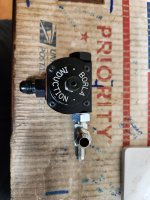steve murray
Well Known Member
In the process of installing SDS fuel injection system, need to monitor the fuel pressure and not real excited about having a bunch of fittings\adaptors to do this. Found this site that has AN fittings with female sensor port. This should help me eliminate a lot of fittings and\or long hose. Curious if anyone else has used these type fittings?
http://www.anhosefittings.com/fittings/sensor-adapter-fittings.html?SID=qr003ae4i9b63p1cdhr4klk1eb
They also they had fire sleeving at much lower cost than spruce.
Ordered some parts, will update once I receive and inspect parts.
http://www.anhosefittings.com/fittings/sensor-adapter-fittings.html?SID=qr003ae4i9b63p1cdhr4klk1eb
They also they had fire sleeving at much lower cost than spruce.
Ordered some parts, will update once I receive and inspect parts.





